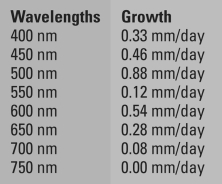Please use the following information to answer the following question(s) .
You work for a company selling tropical rain forest plants commonly found in the understory of the forest. These plants are shade tolerant and can be grown indoors because they require low light. Your employer wants you to find out what is the best type of light to maximize growth of these understory plants. Using a full spectrum of natural light would cause these plants to die because they are a shade-tolerant plant species.
From your biology class, you recall that the light-dependent reactions of photosynthesis involve pigment molecules that absorb light of specific wavelengths. You also remember the experiments done by the German biologist Theodor Engelmann, in which he separated light using a prism into different wavelengths and then determined which wavelengths were best for promoting photosynthesis in the algae species he was examining. Your goal is to determine which wavelengths (colors) of light are best for promoting photosynthesis to enhance growth in your species of plant. To achieve this, you grew your plants under different wavelengths of light and measured their growth rates. The wavelengths were measured in nanometers (nm) , and the growth rate was measured in millimeters per day (mm/day) . The data you collected are as follows:

Make a bar graph plotting growth rates on the y-axis and wavelengths of light on the x-axis. Referring to your graph, answer the following question(s) :
-Of the following,which wavelength is least useful to your plants?
Definitions:
SMB Beta
A measure used in finance to assess the sensitivity of a stock's return relative to the size factor in an asset pricing model.
Factor Portfolio
A portfolio that is constructed to have a high sensitivity to certain economic or financial factors, aiming to capture specific risk premiums.
Well-diversified Portfolio
An investment portfolio comprised of various assets to reduce exposure to risk by spreading investments across different industries, asset classes, or other categories.
Beta
A measure of the volatility, or systematic risk, of a security or portfolio compared to the market as a whole.
Q2: Aquatic organisms _.<br>A) have a waxy coating
Q9: Examine the figure below.In a typical colon
Q11: How is it that the cells in
Q16: Which cookies are less healthy?<br>A) The chocolate
Q18: Chromatin consists of _.<br>A) DNA and protein<br>B)
Q21: What level of ecology is concerned with
Q21: What global climatic change gave gymnosperms an
Q27: Which of the following is a population?<br>A)
Q28: Your family is taking a long driving
Q74: For a two-tailed hypothesis test evaluating the